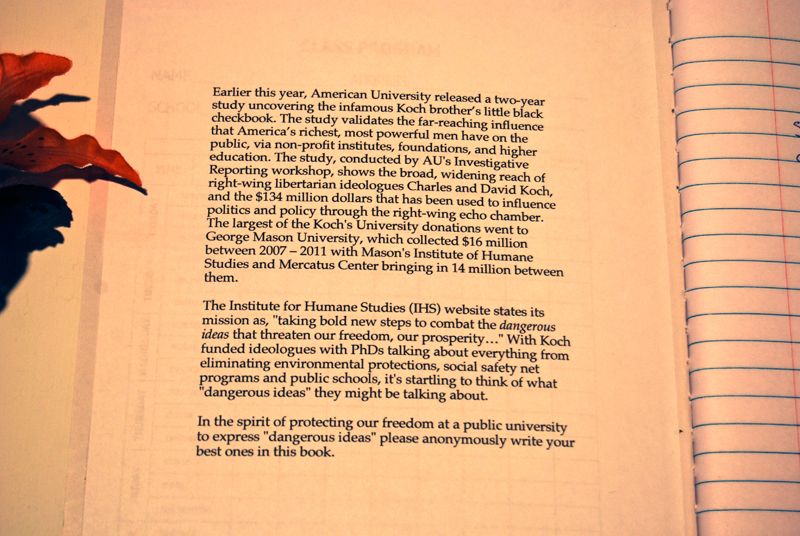
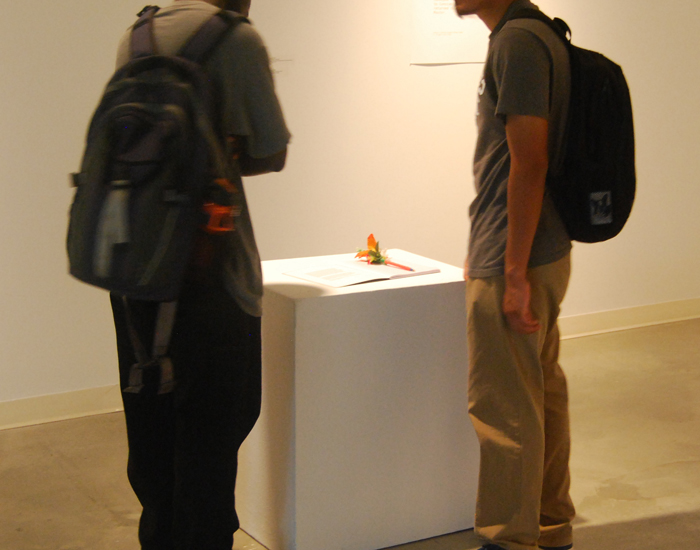

Book of Dangerous Ideas
2013
Ps4. Mark Cooley. Issue 6: Fetish. Katalog
“Agri-Art: The Death of Agri-Culture or Rise of Cooperatives”. Mark Cooley. From Green Acres: Artists Farming Fields, Greenhouses and Abandoned Lots
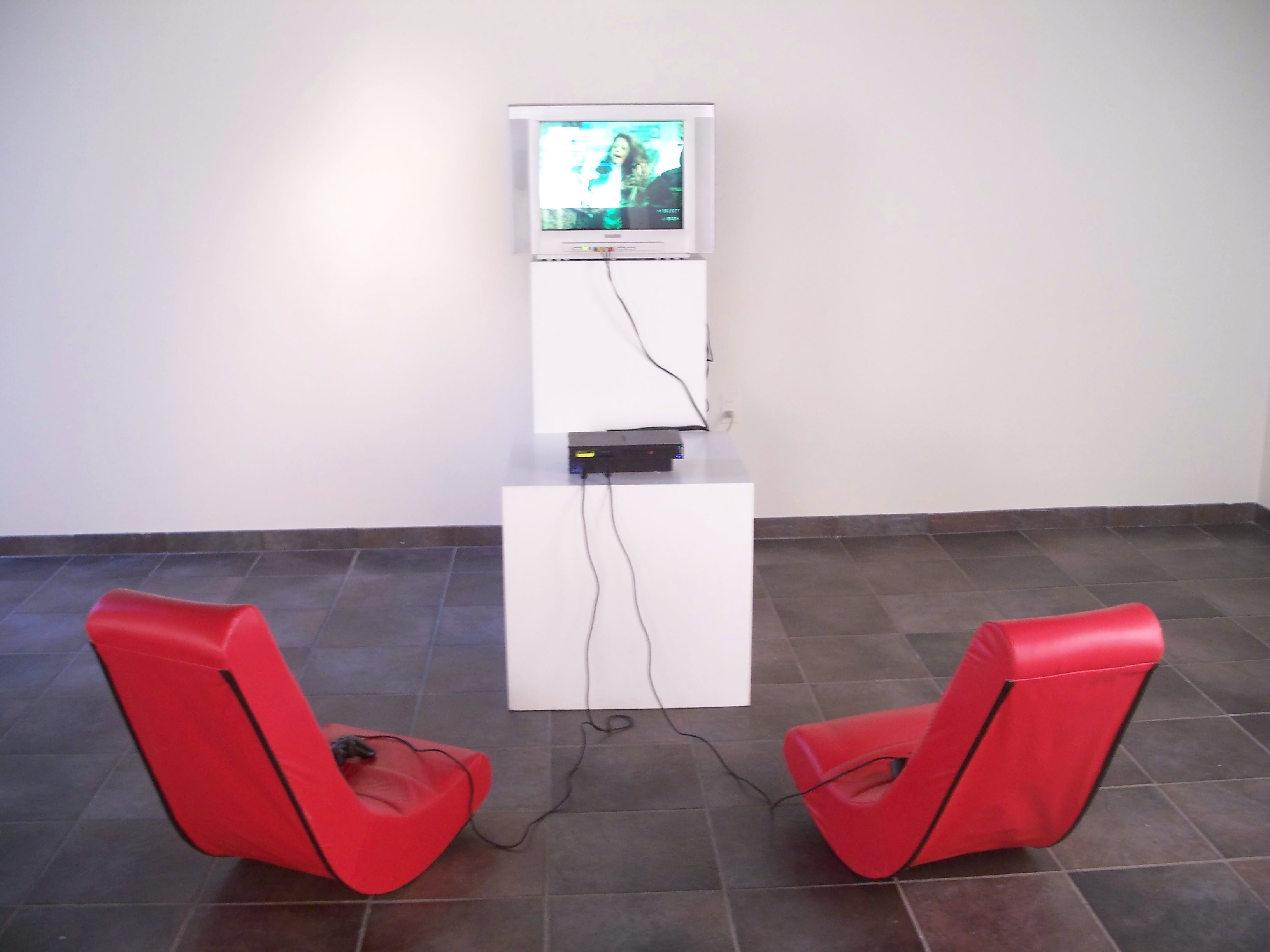 Ps4
Ps4
2008 – 2011
“Kids in Congo were being sent down mines to die so that kids in Europe and America could kill imaginary aliens in their living rooms.” – Oona King, former member of the British Parliament.
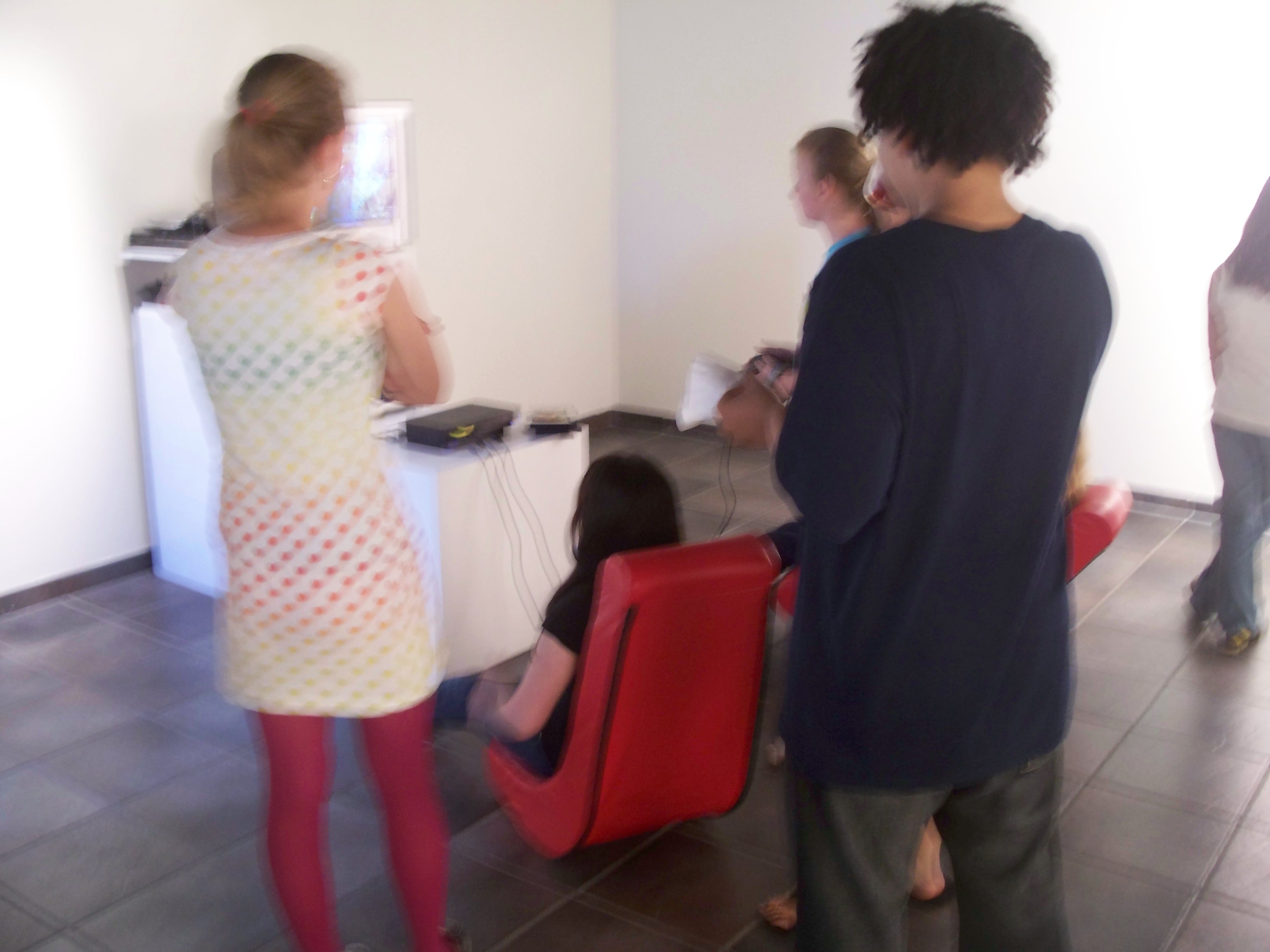
For over a decade, war has ravaged the Democratic Republic of the Congo (DRC). Fueled, in part, by an intense demand for natural resources, the war has claimed over 5 million lives. Coltan (Columbite-tantalite), a metallic ore from which the element tantalum is extracted, is one of the DRC’s most sought after resources. Tantalum is widely used in common electronic devices such as cell phones, computers and video game consoles.
Ps4 is an interactive video mash-up that juxtaposes documentary video footage with live video gameplay. Though initially conceptualized in response to reports of Sony’s large stake in the DRC’s bloody coltan trade during the production of its Playstation 2, Ps4’s playlist has since expanded to look at a variety of issues. On a general level, Ps4 explores the potentially alienating effects of gaming by derailing the seamless gameplay experience and offering a problematic and politicized view of so-called “immersive” leisure activities.
Documentary footage,”Congo’s Bloody Coltan” Produced by, and used with permission from, thePulitzer Center.
Publications
May we never forget (who we work for)
2010
Press Release – Hylton Performing Arts Center
LOCKHEED MARTIN PROVIDES $250,000 TOWARD NEW COMMUNITY PERFORMING ARTS CENTER AT GEORGE MASON UNIVERSITY’S PRINCE WILLIAM CAMPUS
Tuesday, March 27, 2007
“MANASSAS, VA, March 27, 2007 — Lockheed Martin recently pledged $250,000 toward the future Community Performing Arts Center that will be built on George Mason University’s Prince William County campus in Manassas, VA.
The Center, a partnership between Prince William County, the city of Manassas and George Mason University, will create the region’s first state-of-the-art performing arts center, housing an 1,100-seat four-story rehearsal and performance space, two other smaller performance venues, and facilities to support the arts both at the university and in the surrounding community. Under the terms of their pledge, Lockheed Martin will provide the university $250,000 in permanent endowment funds to support the Center over five years. Construction of the Center will begin this summer with an anticipated opening in the fall of 2009.
Denise Saiki, vice president and general manager of Lockheed Martin’s Manassas-based business recently presented the company’s first pledge payment to Dr. Alan G. Merten, president of George Mason University at the university’s Prince William campus in Manassas, VA.
“We are delighted to make this contribution to the Community Performing Arts Center,” said Saiki. “This will allow us to help local high school performing arts education programs and local performing arts organizations use the center for their community programs for many years to come.”
“We are thrilled to welcome Lockheed Martin as a founding partner of the Community Performing Arts Center,” said Bill Reeder, Dean, George Mason University College of Visual and Performing Arts. “Lockheed Martin’s leadership gift will make it possible for the Center to design exciting and innovative programs for schools and families to explore the connections between the arts and science.”
The mission of the new Community Performance Arts Center is to provide world class performance facilities for both well-established, high-quality, regional art groups and the many community-based groups that provide opportunities for residents to actively participate in the arts, as well as, arts-related educational opportunities for area schools.
Headquartered in Bethesda, MD, Lockheed Martin employs about 140,000 people worldwide and is principally engaged in the research, design, development, manufacture, integration and sustainment of advanced technology systems, products and services.”
spacer.gif{ART}
2005

Obsolescence meets timelessness in a new Art form.
What is a “spacer.gif”?
The spacer.gif is a means, employed by web designers, of keeping table-based layouts from collapsing in on themselves. The spacer.gif was once a valuable tool in a net world governed by the interdependence of content and layout. However, to the contemporary high-efficiency web designer, who employs css formatting and layout capabilities, spacer gifs are largely an obsolete and unnecessary tool. The independence of content from layout has come, and spacer gifs, as a concept and as digital objects, are disappearing.
What is spacer.gif{ART}?
As the digital culture industry forges on to virtual territories yet unseen, spacer.gif{ART} hopes to salvage small pieces of the wreckage left behind. spacer.gif{ART} produces and distributes limited edition archival prints of spacer.gif image files downloaded directly from the web by our highly skilled team of curators and techno-conservators. Our portfolio collections represent a dying breed of often unknown artists who utilize(d) the tools of a rapidly fading past to create extraordinary table-based web design experiences. Our curatorial staff hand picks the most extraordinary examples of the spacer.gif to offer to you, our patron, as handsome limited edition archival prints.
More than a parody of http://www.softwareartspace.com, spacer.gif{ART} is simultaneously a functioning ecommerce art site (disabled 2007) and meditation on the projection of artistic value in early and late capitalist society – how, in the digital age (the age of the nonexistent original), art marketers are still relying on analog value systems (based on the the logic of original / copy). It seems we’ve entered the postmodern digital age with much of our modernist baggage still in tow.
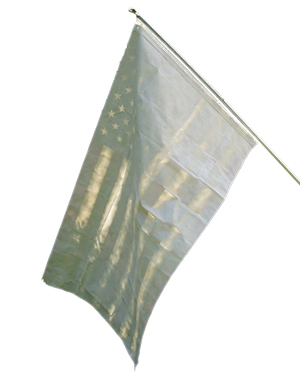
White Flag | 2005
produced for Unfurled Estonia, curated by Pond
Unfurled Exhibition Catalog
Sirp (August 5, 2005)
Posttimes (August 5, 2005)
Terri Cohn. ‘Unfurled.’ /ArtWeek /(7/04)
White Flag is a U.S. flag spray-painted white. Depending on the cultural context a white flag may have various meanings. In the United States the predominant understanding is that a white flag signifies a surrendering – or at least a devious/heroic plan to ensnare the enemy in a deadly bluff. This White Flag is not a celebration of modernist values, or an example of witty iconic pop art. This is one flag become another. Disclaimer: White Flag will fade and crack while exposed to natural and human elements during exterior exhibition thereby, beginning a transformation back to the U.S. flag.
“A U.S. flag painted white, Mark Cooley’s White Flag plays on various cultural resonations. In the United States white flags signify a surrendering – but exposed to natural elements (sun, wind, rain, etc.), White Flag will crack and fade, eventually returning the artwork to its originary incarnation as a piece of cloth. We are left with an open ended question about the evanescent nature of art and the axiomatic character of symbols in the political imaginary. White Flag also alludes to various monochromatic paintings in 20th century Western art (Rodchenko, Robert Ryman, Malevich, Yves Klein, Rothko) that position themselves as the death of painting, a non-painting painting, a blank slate to which we impute meaning. In Cooley’s piece, an actual flag underlies the layers of paint – as if to expose the political and social underpinnings of a Modernist ‘neutral field’.” Press Release, Written by Marisa Jahn
CO.dependency
2004
Produced for the exhibition youGenics – http://www.yougenics.netheld at the Betty Rymer Gallery, School of the Art Institute of Chicago – Curator – Ryan Griffis. 2004
Materials
3 plexiglass vitrine/glove boxes with mirrored bottoms,
Sara Lee™ cheese cake, plate, fork, dinner place cards for Gauguin,
Vuillard and Toulouse-Lautrec.
Wall Text
“Sara Lee’s art collection has made a statement – a quality statement – about our company. Art is all about excellence and vision and striving for perfection – the same standards that we uphold for our portfolio of leading brands. We are quite certain that the ‘brand names’ of Monet, Renoir and Degas have been a great complement to Sara Lee and have become icons of excellence that reflect our approach to doing business. Our gift to America acknowledges our belief that these works of art can provide similar influence and motivation for a broader audience.”
– John H. Bryan, former CEO and current consultant to, Sara Lee Corporation, current director of the Grocery Manufacturers of America, Inc., Chairman of the Board of Trustees of The Art Institute of Chicago, speaking at a 1998 ceremony in honor of Sara Lee’s “Millennium Gift to America,” a public relations initiative through which Sara Lee would give away the top tier of its renowned art collection to museums located throughout the world including The Art Institute of Chicago (AIC). The AIC, which was given paintings by Gauguin and Vuillard, has a close relationship with Sara Lee. The corporation is the sole corporate sponsor of blockbuster exhibitions of artists such as Cassatt and Toulouse-Lautrec as well as the lead corporate sponsor of exhibitions and events of the Betty Rymer gallery.
“The big issue on standards for the Grocery Manufacturers of America is to be sure that people don’t perceive ‘organic’ as superior.”
– Gene Grabowski, vice president of communications for Grocery Manufacturers of America, Inc (GMA), the Washington, D.C.-based industry association, which represents 144 manufacturers of branded consumer packaged goods including Sara Lee. GMA is stridently opposed to labeling genetically engineered ingredients, which are already present in an estimated 60 to 80 percent of supermarket foods in the US. Under intense public pressure in Europe Sara Lee has attempted to avoid GE ingredients in their foods produced for that market, yet in America, Sara Lee has maintained the position of the GMA and their powerful Washington lobby even while shareholders and some legislators have organized to demand a GE moratorium, until long term health and environmental safety testing has been done.
communications
2000
materials: prints of e-mail correspondance between artist and gallery director, cd containing testemonials from laborors in the semiconductor manufacturing industry, cd player, plexiglass, reference binders containing downloads from electronics companies, and labor interest web sites, mirror printed with bar code, shelf, hardware
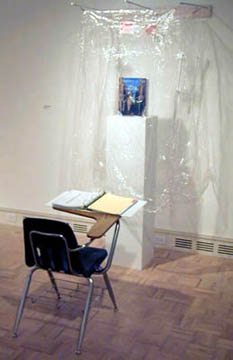
I could live my life in a nutshell and declare myself king of the world had I not bad dreams
1999
Produced for Beeswax, Brackish Water and Junipers, an exhibition of aesthetic representations of environmental concerns, Gray Gallery, East Carolina University.
Materials: oxygen tent, Jansen’s History of Art text, desk chair, pedestal, binder containing data detailing the environmental policies and political campaign contributions of corporations sponsoring museum exhibitions locally and nationally.